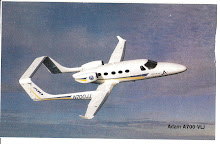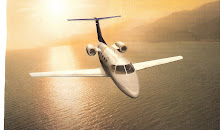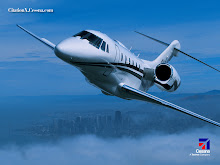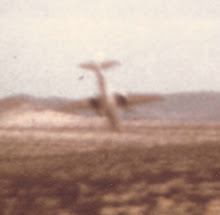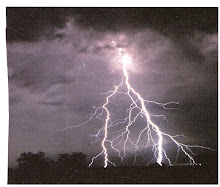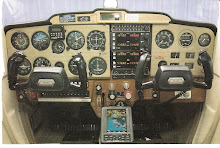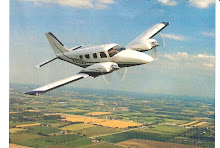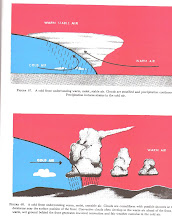Hi Readers: While we're waiting for the count of October 2007 aircraft accidents, here are a few of the "must learn" definitions and facts in flying an airplane of any size. We'll start with airspeed definitions: IAS - indicated airspeed - the number actually read from the airplane airspeed indicator in the cockpit; CAS - calibrated airspeed is the indicated airspeed corrected for position and instrument error; TAS - true airspeed is the speed of an airplane relative to undisturbed air, which is the CAS corrected for altitude, temperature, and compressability; GS - is the speed of an airplane relative to the ground or that speed made good over the ground on a flight, accounting for the direction and velocity of the wind in flight.
Pilots must be familiar with their Airplane Operating Speeds, such as: V1 - normal liftoff speed, V2 - takeoff decision speed, Vr - rotation speed, Va - maneuvering speed, Vc - design cruising speed, Vf - design flap speed, Vfe - maximum flap extend speed, Vle - maximum landing gear extend speed, Vlo - maximum landing gear operating speed, Vmc - minimum control speed with one engine out, Vne - never exceed speed, Vref - final approach speed (1.3 x Vso), Vso - Stall speed, Vx - best angle-of-climb speed (greatest gain of altitude in the shortest horizontal distance), Vy - best rate-of-climb speed (greatest gain in altitude in the shortest possible time).
Standard Weights: Passengers - adults - 170 lbs., children (2-12) - 80 lbs.; Aviation gasoline - 6lbs/gal.; oil - 7.5 lbs/gal; jet fuel - 6.7 lbs/gal; JP-4 fuel - 6.5 lbs/gal.
Loads and Weights: Useful load - difference between takeoff weight and empty weight; Empty Weight - weight of a standard airplane including unuseable fuel, oil and operating fluids; Maximum Takeoff Weight - Highest allowable weight for takeoff; Maximum Landing Weight - highest allowable weight for landing ( in some small airplanes the maximum for both may be the same); Fuel Burn Per Hour - gallons of fuel consumed/hour. Fuel load - useable fuel only.
In addition, the pilot must know the maximum x-wind component for the airplane, which is given in knots; and where to find the useable fuel in gallons, which is usually placarded adjacent to the fuel filler caps.
The Fuel Grades and Colors are as follows: 80 octane - red, 100 octane - green, 100LL octane - blue, 115 octane - purple (for military use), jet fuel - clear or straw-colored.
General Aviation (GA) will use about 268 million gallons of aviation gas and about 1.5 million gallons of jet fuel in 2007. Air Carrier (AC) will use about 20 million gallons of jet fuel in 2007.
Thanks for listening. R.S.
Wednesday, October 31, 2007
Sunday, October 28, 2007
Did You Know
Hi Readers: This is October 28, 2007-Did you know day.
The Earth - The earth is the third planet from the sun, and the largest of all the terrestrial planets in our solar system.
Sputnik - At the time of sputnick, in 1937, there was just one undersea telephone cable connecting the U.S. with Europe, carrying only 36 simultaneous calls. Today, fiber-optic cables and communications satellites make long distance calls routine.
Meteorology - The atmosphere transports insects, pollutants, sand, bacteria, and viruses between continents. Sand, for instance, from the Chinese desert rountinely rains down on the West Coast of the U.S., bringing microbes with it.
Inflation - The idea of using "a basket of goods" to measure inflation goes back to the Revolutionary War. Massachusetts paid it's soldiers the amount of money that would buy the following basket of goods: 5 bushels of corn, 68 and 4/7 pounds of beef, 10 pounds of wood, and 16 pounds of leather.
The Color of Stars - The surface temperature of a star determines it's color. The hottest stars are bluish in color, the coldest are reddish. Stars at intermediate temperatures appear white. Would you believe that the sun is a white star?
The October aircraft accident accounting is coming up. Thanks for listening. R.S.
The Earth - The earth is the third planet from the sun, and the largest of all the terrestrial planets in our solar system.
Sputnik - At the time of sputnick, in 1937, there was just one undersea telephone cable connecting the U.S. with Europe, carrying only 36 simultaneous calls. Today, fiber-optic cables and communications satellites make long distance calls routine.
Meteorology - The atmosphere transports insects, pollutants, sand, bacteria, and viruses between continents. Sand, for instance, from the Chinese desert rountinely rains down on the West Coast of the U.S., bringing microbes with it.
Inflation - The idea of using "a basket of goods" to measure inflation goes back to the Revolutionary War. Massachusetts paid it's soldiers the amount of money that would buy the following basket of goods: 5 bushels of corn, 68 and 4/7 pounds of beef, 10 pounds of wood, and 16 pounds of leather.
The Color of Stars - The surface temperature of a star determines it's color. The hottest stars are bluish in color, the coldest are reddish. Stars at intermediate temperatures appear white. Would you believe that the sun is a white star?
The October aircraft accident accounting is coming up. Thanks for listening. R.S.
Saturday, October 27, 2007
The California Fires
With several fires still burning in Southern California on Saturday, 10-27-07, the horrible tradegy is still on our minds, and the aftermath is just starting. Before the mass exodus of volunteers and equipment and the rebuilding gets underway, let's thank all the firefighters, forestry people, pilots, volunteers, care-givers, and donors that brought it all to an end.
We all saw it on TV, spectacular, but heart-breaking, and we felt for the animals. But they were cared for, too. In my time, this was the worst fire I've ever seen. The volunteer of people and equipment from other States was fantastic. Even volunteer firefighters from Mexico, too. GA airports were being used as bases and staging areas for both ground and air firefighting operations.
It was a sight to see all the tankers dropping slurry and water on the high-rising flames and smoke, all against fierce Santa Ana winds. Department of Homeland Security Kerchoff reported on the fires, citing 90 tanker airplanes and helicopters of all sizes, operating from various airports and bases. There were Grumman S-2 airtankers, UH-1H Super Huey helicopters, the OV-10As from the Dept of Forestry, C-130 aircraft tankers, and a DC-10 air tanker. Firefighters came from all across the Country to help.
The aftermath and the recovery, I'm sure, will continue for months. The damage to property was estimated in excess of $ 1 Billion dollars. The damage to human suffering is unthinkable. What can be done to prevent the fires from happening in the future - it's going to take a lot of thought and planning from everyone. Let's start by getting rid of the arsonists promptly. The weather - we'll have to mediate.
Thanks for listening. R.S.
We all saw it on TV, spectacular, but heart-breaking, and we felt for the animals. But they were cared for, too. In my time, this was the worst fire I've ever seen. The volunteer of people and equipment from other States was fantastic. Even volunteer firefighters from Mexico, too. GA airports were being used as bases and staging areas for both ground and air firefighting operations.
It was a sight to see all the tankers dropping slurry and water on the high-rising flames and smoke, all against fierce Santa Ana winds. Department of Homeland Security Kerchoff reported on the fires, citing 90 tanker airplanes and helicopters of all sizes, operating from various airports and bases. There were Grumman S-2 airtankers, UH-1H Super Huey helicopters, the OV-10As from the Dept of Forestry, C-130 aircraft tankers, and a DC-10 air tanker. Firefighters came from all across the Country to help.
The aftermath and the recovery, I'm sure, will continue for months. The damage to property was estimated in excess of $ 1 Billion dollars. The damage to human suffering is unthinkable. What can be done to prevent the fires from happening in the future - it's going to take a lot of thought and planning from everyone. Let's start by getting rid of the arsonists promptly. The weather - we'll have to mediate.
Thanks for listening. R.S.
Thursday, October 25, 2007
Temporary Flight Restrictions
Hi Readers: When you buy a bottle of 80-proof liquor, do you really know what you are getting? Yes, it would be alcohol. Distillers say that in "colonel times", if liquor were put on gunpowder and it burned, that it was "proved" or "proof" that alcohol was really in the liquor. Thus, the formula: 1/2 of 1% of each unit of liquor = the alcohol in it. 1/2 of 1% x 80 proof = 40% alcohol. 100 proof would contain 50% alcohol. Now for an important and appropo topic:
In view of the many airshows across the country and the numerous fires concentrated in one area in California, and the NASA space operations, this is probably a good time to discuss Temporary Flight Restrictions (TFR). Okay, so what is a TFR and why is it so important?
There are many reasons, as given by FAA, for the TFRs: 1. To protect persons and property from an existing or iminent hazard associated with an incident on the surface when the presence of low flying aircraft would magnify, alter, spread or compound that hazard. 2. Provide a safe environment for the operation of disaster relief aircraft. 3. Prevent an unsafe congestion of sightseeing aircraft above an incident or event which may generate a high degree of public interest. 4. Protect declared national disasters for humanitarian reasons in the state of Hawaii. 5. Protect the President, Vice President, or other public figures of the U.S. 6. Provide a safe environment for Space Agency operations. Aerial Demonstrations and major Sporting Events are included in this classification.
You can imagine the importance of the TFR with respect to the California fires, concentrated from San Diego to Santa Barbara and into the most populated areas of Los Angeles, involving air drop operations and movement of firefighters by helicopter. You can see that no other flight activity be allowed during this time, into, around, or out of the area. The visit of the President on Thursday, 10-25-07, to view the area, makes a TFR all the more important.
How are we advised of the TFRs - by Notices To Airmen (NOTAMs) that are issued almost daily. Infact, the NOTAM system was designed to disseminate time-critical aeronautical information of either a temporary nature or not sufficiently known in advance to permit publication on charts or other operational publications.
NOTAM information is aeronautical information that could affect a pilot's decision to make a flight; such as airport or runway closures; changes in the status of navigational aids; ILS's; radar service availability; and other information essential to planned en route, terminal, or landing operations.
NOTAM information is transmitted using standard contractions to reduce transmission time. The information is classified by categories: NOTAM D (distant), NOTAM L (local), and Flight Data Center (FDC), Each of these NOTAM categories are important to the pilot, depending on the nature of the reason for the NOTAM. NOTAMs are a study in themselves, covering many categories and operational complications.
One of the requirements of a proposed flight is checking the appropriate NOTAMs, normally through an automated Flight Service Station (AFSS), a local FSS, or any navigational facility, or perhaps an organization such as AOPA or Others accepting Flight Plan Filings. It is recommended that pilots consult a FSS briefer to discuss recent and current NOTAMs before filing a flight plan.
Thanks for listening. R.S.
In view of the many airshows across the country and the numerous fires concentrated in one area in California, and the NASA space operations, this is probably a good time to discuss Temporary Flight Restrictions (TFR). Okay, so what is a TFR and why is it so important?
There are many reasons, as given by FAA, for the TFRs: 1. To protect persons and property from an existing or iminent hazard associated with an incident on the surface when the presence of low flying aircraft would magnify, alter, spread or compound that hazard. 2. Provide a safe environment for the operation of disaster relief aircraft. 3. Prevent an unsafe congestion of sightseeing aircraft above an incident or event which may generate a high degree of public interest. 4. Protect declared national disasters for humanitarian reasons in the state of Hawaii. 5. Protect the President, Vice President, or other public figures of the U.S. 6. Provide a safe environment for Space Agency operations. Aerial Demonstrations and major Sporting Events are included in this classification.
You can imagine the importance of the TFR with respect to the California fires, concentrated from San Diego to Santa Barbara and into the most populated areas of Los Angeles, involving air drop operations and movement of firefighters by helicopter. You can see that no other flight activity be allowed during this time, into, around, or out of the area. The visit of the President on Thursday, 10-25-07, to view the area, makes a TFR all the more important.
How are we advised of the TFRs - by Notices To Airmen (NOTAMs) that are issued almost daily. Infact, the NOTAM system was designed to disseminate time-critical aeronautical information of either a temporary nature or not sufficiently known in advance to permit publication on charts or other operational publications.
NOTAM information is aeronautical information that could affect a pilot's decision to make a flight; such as airport or runway closures; changes in the status of navigational aids; ILS's; radar service availability; and other information essential to planned en route, terminal, or landing operations.
NOTAM information is transmitted using standard contractions to reduce transmission time. The information is classified by categories: NOTAM D (distant), NOTAM L (local), and Flight Data Center (FDC), Each of these NOTAM categories are important to the pilot, depending on the nature of the reason for the NOTAM. NOTAMs are a study in themselves, covering many categories and operational complications.
One of the requirements of a proposed flight is checking the appropriate NOTAMs, normally through an automated Flight Service Station (AFSS), a local FSS, or any navigational facility, or perhaps an organization such as AOPA or Others accepting Flight Plan Filings. It is recommended that pilots consult a FSS briefer to discuss recent and current NOTAMs before filing a flight plan.
Thanks for listening. R.S.
Labels:
AFSS,
air travel,
Airline pilots,
airlines,
Aviation careers,
cargo,
fires,
Flight Planning,
flying hours,
forecasts,
FSS,
Los Angeles,
Natural Disasters,
Navigation,
NOTAM,
TFR,
The President
Thursday, October 18, 2007
In Between
Hi Readers: I came across this Nonsense Poetry (?) in searching my voluminous files for my next subject.
Every Now and Then
Every now and then, a story unfolds,
a story never to be told,
To good to keep, it finds its way,
to ears of utter dismay.
Its secrecy is sworn, but not well-worn,
and the story passes along its way.
As it came to me, I could easily see,
this story must not further be.
The Flapping Machine
The dreams of men are often extreme,
some pleasurable, some mean,
Yet, always leading to progress.
Such was the case of E. Van Cleeve,
who invented the flapping machine.
Extreme it was, highly useful, one and the same,
that flapping machine became the helicopter.
Every Now and Then
Every now and then, a story unfolds,
a story never to be told,
To good to keep, it finds its way,
to ears of utter dismay.
Its secrecy is sworn, but not well-worn,
and the story passes along its way.
As it came to me, I could easily see,
this story must not further be.
The Flapping Machine
The dreams of men are often extreme,
some pleasurable, some mean,
Yet, always leading to progress.
Such was the case of E. Van Cleeve,
who invented the flapping machine.
Extreme it was, highly useful, one and the same,
that flapping machine became the helicopter.
Sunday, October 14, 2007
September 2007 Aircraft Accidents/Incidents
Hi Readers: Its time to review the September Accident/Incidents as reported by NTSB. There were 98 accidents and 2 incidents (7 non-U.S. accidents) of which 36 were fatal accidents accounting for 134 fatalities.
One incident was a Part 121 Air Carrier DC-9 engine fire warning in flight, and the other was a night VFR incident in which the Tower Controller instructed a Part 135 Lear Jet pilot to taxi into position and hold on R19R at Potomac airport in Washington D.C. Runway 19R was actually closed and the runway lights were off. The runway closure was advertised on ATIS and the closure was placed on the ground radar display in the Tower. The Tower Controller then cleared the pilot for takeoff. The FAA classified the incident as an operational error.
The September accidents, particularly the fatal accidents, show a conglomeration of accident types and indicated probable causes. There were 8 takeoff accidents (3 engine failures, 5 stalls or failure to clear trees and terrain); 9 loss of control and/or maneuvering at low altitude, including spin-ins; a collision of 2 airplanes, and a loss of control of one airplane, during the Reno, Nevada Air Races; one inflight collision with mountains; one flying into a thunderstorm and a crash shedding airplane parts; one formation-demonstration crash; 3 unknowns; one helicopter tail boom and rotor failure inflight; one where the passenger walked into the main rotor; and the accident involving Steve Fossett (never found). There was one GPS approach accident - a second attempt in a 100 ft overcast, with 1/4 mile visibility, and a zero temperature-dewpoint spread, resulting in 3 fatalities.
One fatality, and one serious injury, U.S. Customs accident, practising touch-an-go maneuvers, attempting a full-flap, short field landing, involved dropping the airplane in to the runway (10-12 ft.) and a bounce airborne, then a drift to the right of the runway centerline. The pilot applied power, resulting in a 30 to 40 ft pitchup and stall, further resulting in impact with terrain in a nose-low attitude and following fire. ( A typical example of how not to land an airplane)
One accident indicated an overload of the airplane on takeoff, resulting in 5 fatalities.
In general, we must conclude that the sum total of the accidents reflect carelessness, failure to follow the rules, poor decisions, and poor judgment. These accidents show deviation from safety of flight, and the type of accidents we would like to prevent. Also, unfortuneately, the type of accidents most likely to result in fatalities.
The poor judgment accidents continue for lack of knowledge and training. The poor planning and poor decision accidents we can correct, particularly those accidents involving X-C flight and weather. The carelessness and recklessness - Pilots must follow the rules.
We can attack the safety aspects of flying by separations, such as: 1. Local and X-C flight; 2. Pilot experience - flight hours, certificates, and proficiency issues; 3. Pilot - aircraft type certification; 4. VFR - IFR flying; 5.Rules and Regulations; 6. Aeronautical knowledge.
Supposedly we are doing this now - so what are we doing wrong?
Thanks for listening. R.S.
One incident was a Part 121 Air Carrier DC-9 engine fire warning in flight, and the other was a night VFR incident in which the Tower Controller instructed a Part 135 Lear Jet pilot to taxi into position and hold on R19R at Potomac airport in Washington D.C. Runway 19R was actually closed and the runway lights were off. The runway closure was advertised on ATIS and the closure was placed on the ground radar display in the Tower. The Tower Controller then cleared the pilot for takeoff. The FAA classified the incident as an operational error.
The September accidents, particularly the fatal accidents, show a conglomeration of accident types and indicated probable causes. There were 8 takeoff accidents (3 engine failures, 5 stalls or failure to clear trees and terrain); 9 loss of control and/or maneuvering at low altitude, including spin-ins; a collision of 2 airplanes, and a loss of control of one airplane, during the Reno, Nevada Air Races; one inflight collision with mountains; one flying into a thunderstorm and a crash shedding airplane parts; one formation-demonstration crash; 3 unknowns; one helicopter tail boom and rotor failure inflight; one where the passenger walked into the main rotor; and the accident involving Steve Fossett (never found). There was one GPS approach accident - a second attempt in a 100 ft overcast, with 1/4 mile visibility, and a zero temperature-dewpoint spread, resulting in 3 fatalities.
One fatality, and one serious injury, U.S. Customs accident, practising touch-an-go maneuvers, attempting a full-flap, short field landing, involved dropping the airplane in to the runway (10-12 ft.) and a bounce airborne, then a drift to the right of the runway centerline. The pilot applied power, resulting in a 30 to 40 ft pitchup and stall, further resulting in impact with terrain in a nose-low attitude and following fire. ( A typical example of how not to land an airplane)
One accident indicated an overload of the airplane on takeoff, resulting in 5 fatalities.
In general, we must conclude that the sum total of the accidents reflect carelessness, failure to follow the rules, poor decisions, and poor judgment. These accidents show deviation from safety of flight, and the type of accidents we would like to prevent. Also, unfortuneately, the type of accidents most likely to result in fatalities.
The poor judgment accidents continue for lack of knowledge and training. The poor planning and poor decision accidents we can correct, particularly those accidents involving X-C flight and weather. The carelessness and recklessness - Pilots must follow the rules.
We can attack the safety aspects of flying by separations, such as: 1. Local and X-C flight; 2. Pilot experience - flight hours, certificates, and proficiency issues; 3. Pilot - aircraft type certification; 4. VFR - IFR flying; 5.Rules and Regulations; 6. Aeronautical knowledge.
Supposedly we are doing this now - so what are we doing wrong?
Thanks for listening. R.S.
Friday, October 12, 2007
Bits and Pieces
Hi Readers: The current cost of 100LL aviation fuel is $4.52/gal and Jet A fuel is $4.27/gal.
FAA is now pushing pilots to upgrade their electronics to include ADS-B, Automatic Dependent Surveillance - Broadcast for the future. Although the target date for full operation is the year 2020, it will take a while and some dollars.
As if we didn't have enough advertising in our lives, I learned from AVWEB, an aviation information source, that the AD - AIR company in London is selling 5-acre inflatable ads that lay across the landscape to be seen from the air by passengers of Airlines in flight. Atlanta, Denver, and Los Angeles Intl airports are target possibilities. I wish them luck in finding a 5-acre lot near Los Ageles Intl. What will we think of next?
BRS, Ballistic Recovery Systems, Inc., manufacturers of whole aircraft parachute systems (such as installed on the Sirius airplane), seatbelts and airbags for automobiles, etc. is now advertising their products for the Cessna 172/182 airplanes, and Experimental and Sports airplanes. Cessna will have the equipment installed in the Skycatcher airplane. The product, a ballistic type charge, has been available for some time, with a deployment speed from 138 mph to over 200 mph, and at an estimated cost from $2,608 to $17,881. This could be a boon for GA safety if all goes well.
GA aircraft accidents show that even high-time Commercial and Air Transport pilots need knowledge and training in selecting and analyzing Weather Services reports in connection with their flight planning. The desired X-C flight level, or changes in flight level, direct flight and alternate routes, below clouds or over-the-top flight, cloud ceilings ahead, hazardous weather en route and at destination, and en route accounts of destination weather are some of the important needs revealed. Avoiding precipitation areas and icing levels are a must in the X-C flight planning. The leading contributing factor in GA accidents is the weather, and takeoff is really only the beginning of the flight plan.
Thanks for listening. R.S.
FAA is now pushing pilots to upgrade their electronics to include ADS-B, Automatic Dependent Surveillance - Broadcast for the future. Although the target date for full operation is the year 2020, it will take a while and some dollars.
As if we didn't have enough advertising in our lives, I learned from AVWEB, an aviation information source, that the AD - AIR company in London is selling 5-acre inflatable ads that lay across the landscape to be seen from the air by passengers of Airlines in flight. Atlanta, Denver, and Los Angeles Intl airports are target possibilities. I wish them luck in finding a 5-acre lot near Los Ageles Intl. What will we think of next?
BRS, Ballistic Recovery Systems, Inc., manufacturers of whole aircraft parachute systems (such as installed on the Sirius airplane), seatbelts and airbags for automobiles, etc. is now advertising their products for the Cessna 172/182 airplanes, and Experimental and Sports airplanes. Cessna will have the equipment installed in the Skycatcher airplane. The product, a ballistic type charge, has been available for some time, with a deployment speed from 138 mph to over 200 mph, and at an estimated cost from $2,608 to $17,881. This could be a boon for GA safety if all goes well.
GA aircraft accidents show that even high-time Commercial and Air Transport pilots need knowledge and training in selecting and analyzing Weather Services reports in connection with their flight planning. The desired X-C flight level, or changes in flight level, direct flight and alternate routes, below clouds or over-the-top flight, cloud ceilings ahead, hazardous weather en route and at destination, and en route accounts of destination weather are some of the important needs revealed. Avoiding precipitation areas and icing levels are a must in the X-C flight planning. The leading contributing factor in GA accidents is the weather, and takeoff is really only the beginning of the flight plan.
Thanks for listening. R.S.
Tuesday, October 2, 2007
Wind Shear - Part II
My preliminary study of the weather-related aircraft accidents and incidents indicate, still, a general lack of awareness of wind shear and it's ramifications by all pilots, particularly by GA pilots, and pertaining to low altitude and surface operations in and around airports. By the nature of their operations, airline pilots are better informed and also supported by their Company training and cockpit detection equipment.
NASA, FAA, and NTSB have spent considerable effort in identifying, defining, and investigating microbursts and wind shear since 1985. To date the awareness of wind shear and the detection by pilots is still only general and is complicated by the required use of several weather systems to detect (which must be secured by the pilot separately) and which must be dispersed to the pilot through the Controller.
As pointed out in Wind Shear I, over the years the airlines have experienced the major catastrofic accidents in connection with wind shear. NTSB, following their investigations have faulted, mainly, the crews for initiating and continuing flight into the related microburst and rainshaft emanating from the thunderstorms. The contributing causes, however, (as they often do) appear to be the root of the problem - the lack of specific guidelines, procedures, and training for avoiding the end result, that of wind shear.
We also know that there have been occurrences of wind shear experienced by GA pilots on VFR and IFR flights. Fortuneately, most were handled successfully. Considering the current volume of flying, and expected increase in the future, it is my opinion (in the interest of safety) that the need exists for a simplified system of wind shear detection and avoidance in the cockpit. Such a system must be capable of relieving the pilot and the controller of excess duties.
For the time being, and until Avionics manufacturers, FAA, and others settle on an affordable cockpit wind shear detection instrument, for both airline and GA operations, the best advice appears to be: 1. Do not fly into and through thunderstorms, if at all possible; particularly through the thunderstorm rainshaft, and during low altitude operations such as approach, landing, and takeoff. 2. Check the en route and destination weather thoroghlybefore flight using the IWAS, LLWAS, TDWR, WSP systems for wind shear. 3. When in doubt, talk to the appropriate controller regarding hazardous weather ahead in flight. 4. Then adjust your flight plans accordingly - don't wait! Thanks for listening. R.S.
NASA, FAA, and NTSB have spent considerable effort in identifying, defining, and investigating microbursts and wind shear since 1985. To date the awareness of wind shear and the detection by pilots is still only general and is complicated by the required use of several weather systems to detect (which must be secured by the pilot separately) and which must be dispersed to the pilot through the Controller.
As pointed out in Wind Shear I, over the years the airlines have experienced the major catastrofic accidents in connection with wind shear. NTSB, following their investigations have faulted, mainly, the crews for initiating and continuing flight into the related microburst and rainshaft emanating from the thunderstorms. The contributing causes, however, (as they often do) appear to be the root of the problem - the lack of specific guidelines, procedures, and training for avoiding the end result, that of wind shear.
We also know that there have been occurrences of wind shear experienced by GA pilots on VFR and IFR flights. Fortuneately, most were handled successfully. Considering the current volume of flying, and expected increase in the future, it is my opinion (in the interest of safety) that the need exists for a simplified system of wind shear detection and avoidance in the cockpit. Such a system must be capable of relieving the pilot and the controller of excess duties.
For the time being, and until Avionics manufacturers, FAA, and others settle on an affordable cockpit wind shear detection instrument, for both airline and GA operations, the best advice appears to be: 1. Do not fly into and through thunderstorms, if at all possible; particularly through the thunderstorm rainshaft, and during low altitude operations such as approach, landing, and takeoff. 2. Check the en route and destination weather thoroghlybefore flight using the IWAS, LLWAS, TDWR, WSP systems for wind shear. 3. When in doubt, talk to the appropriate controller regarding hazardous weather ahead in flight. 4. Then adjust your flight plans accordingly - don't wait! Thanks for listening. R.S.
Subscribe to:
Posts (Atom)

